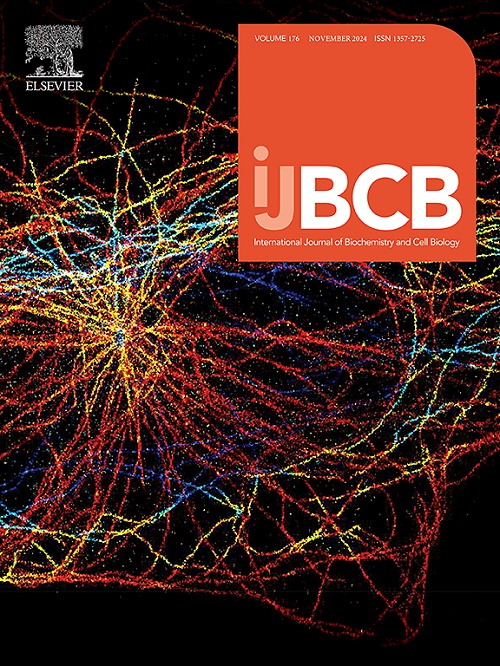Single-cell transcriptomics and metabolomics reveal the potential role of ASRGL1 in metabolic reprogramming and invasion of nasopharyngeal carcinoma cells
IF 2.8
3区 生物学
Q2 BIOCHEMISTRY & MOLECULAR BIOLOGY
International Journal of Biochemistry & Cell Biology
Pub Date : 2025-05-02
DOI:10.1016/j.biocel.2025.106788
引用次数: 0
Abstract
Nasopharyngeal carcinoma (NPC) is an aggressive and highly metastatic malignancy, presenting significant challenges for early diagnosis and treatment. Asparaginase-like protein 1 (ASRGL1) is an important enzyme involved in amino acid metabolism, and previous studies have linked it to the progression of various tumors. However, the specific role of ASRGL1 in NPC remains unclear. This study analyzed multiple publicly available datasets related to NPC. We conducted single-cell RNA sequencing (scRNA-seq) analysis on the GSE150430 dataset to identify different cell subpopulations and examine ASRGL1 expression and its functional implications. The expression of ASRGL1 and its correlation with EMT were validated using transcriptomic data. The expression of ASRGL1 in C666–1 cells was interfered with by siRNA, cell proliferation and invasion were detected by CCK8, EdU, plate cloning, Transwell and scratch method, and EMT was evaluated by detecting the expression of E-cadherin and N-cadherin. Amino acid metabolomics and GC-MS headspace metabolomics were used to analyze the effects of ASRGL1 knockdown on the metabolic pattern of NPC cells. This study found that ASRGL1 was mainly expressed in fibroblasts, epithelial cells and myeloid cells in nasopharyngeal carcinoma (NPC). The ASRGL1-cell gene was significantly enriched in the epithelial-mesenchymal transition pathway. Knocking down ASRGL1 can further inhibit the proliferation, invasion and EMT of C666–1 cells. At the same time, the utilization of various amino acids was significantly reduced, and further GC-MS metabolomics analysis showed that the cell metabolism was unbalanced. This study elucidates the expression characteristics and potential functional roles of asparaginase-like protein 1 (ASRGL1) in nasopharyngeal carcinoma (NPC), providing new insights into its potential as a diagnostic marker and therapeutic target.
单细胞转录组学和代谢组学揭示了ASRGL1在鼻咽癌细胞代谢重编程和侵袭中的潜在作用
鼻咽癌(NPC)是一种侵袭性和高转移性的恶性肿瘤,对早期诊断和治疗提出了重大挑战。天冬酰胺酶样蛋白1 (ASRGL1)是参与氨基酸代谢的重要酶,以往的研究已将其与多种肿瘤的进展联系起来。然而,ASRGL1在NPC中的具体作用尚不清楚。本研究分析了与NPC相关的多个公开可用数据集。我们对GSE150430数据集进行了单细胞RNA测序(scRNA-seq)分析,以确定不同的细胞亚群,并研究ASRGL1的表达及其功能意义。利用转录组学数据验证ASRGL1的表达及其与EMT的相关性。采用siRNA干扰C666-1细胞中ASRGL1的表达,采用CCK8、EdU、平板克隆、Transwell和scratch法检测细胞的增殖和侵袭,并通过检测E-cadherin和N-cadherin的表达来评估EMT。利用氨基酸代谢组学和气相色谱-质谱顶空代谢组学分析ASRGL1敲低对鼻咽癌细胞代谢模式的影响。本研究发现ASRGL1主要在鼻咽癌的成纤维细胞、上皮细胞和髓样细胞中表达。asrgl1细胞基因在上皮-间质转化途径中显著富集。下调ASRGL1可进一步抑制C666-1细胞的增殖、侵袭和EMT。同时,各种氨基酸的利用率明显降低,进一步的GC-MS代谢组学分析表明细胞代谢不平衡。本研究阐明了天冬酰胺酶样蛋白1 (ASRGL1)在鼻咽癌(NPC)中的表达特征及其潜在的功能作用,为其作为诊断标志物和治疗靶点的潜力提供了新的见解。
本文章由计算机程序翻译,如有差异,请以英文原文为准。
求助全文
约1分钟内获得全文
求助全文
来源期刊
CiteScore
8.10
自引率
0.00%
发文量
124
审稿时长
19 days
期刊介绍:
IJBCB publishes original research articles, invited reviews and in-focus articles in all areas of cell and molecular biology and biomedical research.
Topics of interest include, but are not limited to:
-Mechanistic studies of cells, cell organelles, sub-cellular molecular pathways and metabolism
-Novel insights into disease pathogenesis
-Nanotechnology with implication to biological and medical processes
-Genomics and bioinformatics

 求助内容:
求助内容: 应助结果提醒方式:
应助结果提醒方式:


